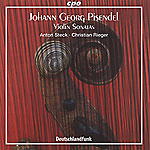Period-instrument violinist Anton Steck opens this program with a spirited Allegro from Johann Pisendel’s Sonata in D major, sporting a flashy series of runs highly reminiscent of the florid solo-violin entrance featured prominently in the opening “Spring” movement from Vivaldi’s Four Seasons. As one of Vivaldi’s most beloved students, Pisendel certainly learned plenty from the master, as he did from his many other mentors and friends–Bach, Telemann, Zelenka, Heinichen, Torelli, Hasse, and just about every other major figure of the high Baroque. In fact, listening to Steck’s often driven performances of these five expertly crafted sonatas reveals Pisendel to be a highly accomplished virtuoso content to shun originality and instead simply inspire others (Bach, for example, composed his renowned Sonatas and Partitas for solo violin BWV 1001-1006 with Pisendel in mind) or masterfully emulate his contemporaries.
Though technically flawless and on one level true to Pisendel’s reputation, Steck has a tendency to overemphasize the virtuosic possibilities at the expense of the lyrical shape and variety of expression inherent in these works. For example, Steck’s flashy entrance differs significantly from Adrian Chandler’s rendering on Avie (type Q6525 in Search Reviews), which takes the same opening at such a slower pace that at first you may not recognize it as the same piece. Throughout the Sonata Steck likewise adopts extremes of tempo and dynamics that are often thrilling though at times sound unnecessarily mannered. Chandler’s more moderate (though never dull) articulation enables him to better extract and refine detail, which, when aided by cello continuo and harpsichord and Avie’s comparatively better sound, results in a more satisfying whole. CPO’s sound is fine, if just a little bass shy, with Steck placed slightly forward in the mix.
































